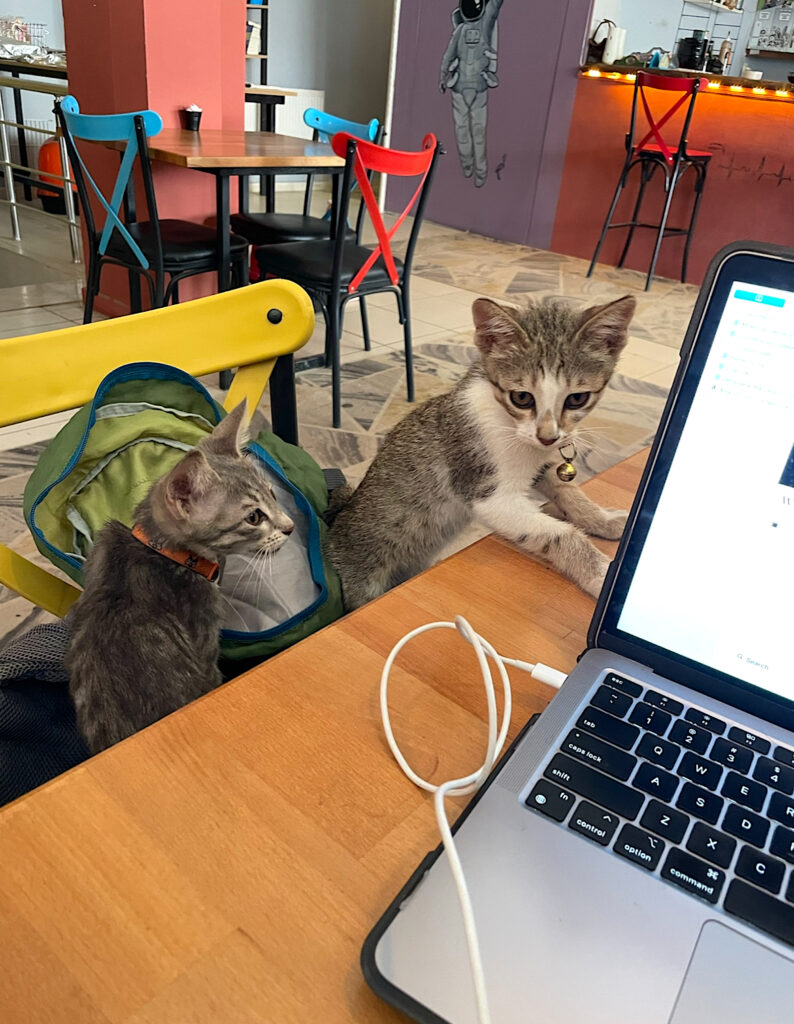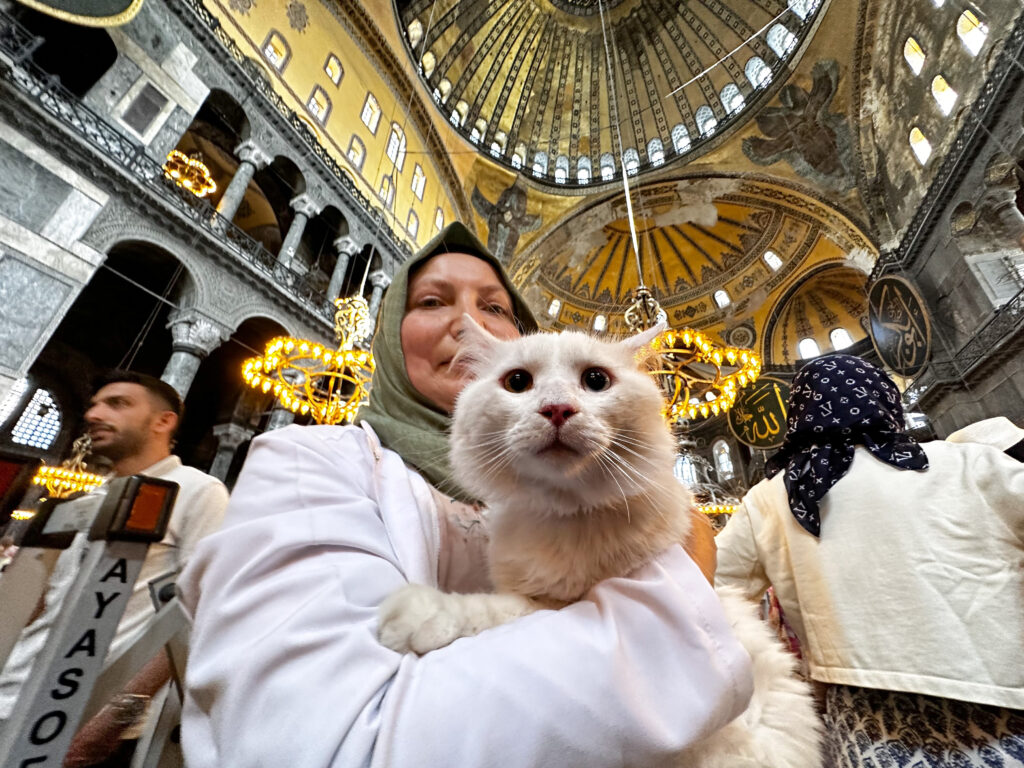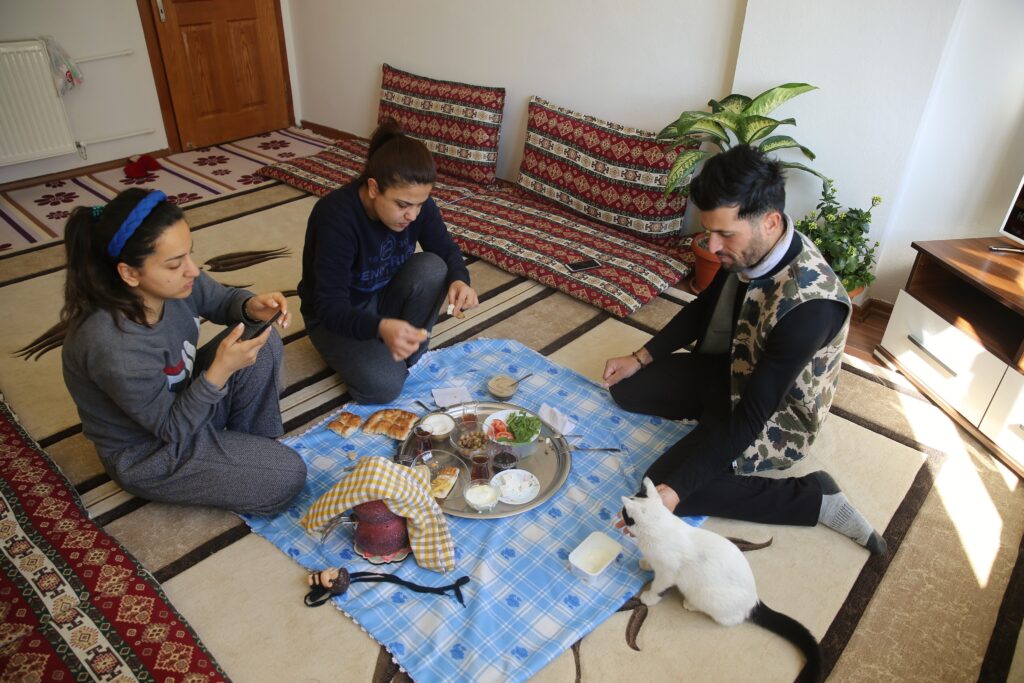For the Love of Cats in Turkey
While visiting eastern Turkey to climb Mount Ararat, I discovered a nice cafe called Ru Sahaf in the town of Doğubayazıt. I had arrived days before the hike and was looking for a place to work remotely. The cafe had nice chairs, jazz music, good coffee, and decent internet: a perfect spot.
To my surprise, as I was in the middle of writing, two kittens—gray tabbies wearing collars with bells—walked up to me. Without hesitating, they made themselves comfortable in my lap.
Now, I have been to cat cafes around the world, but they are usually designated as such—Catfecito in a neighborhood where I lived in Mexico City or the numerous cat cafes in different Tokyo neighborhoods. But Ru Sahaf was not a cat cafe, so I was surprised by the kittens’ sudden appearance.
I quickly got used to having the creatures on my lap—or crawling over my laptop. When I would be lost in thought, meeting their stares would provide a welcome distraction, and I came to enjoy their company. Several days later, after I successfully climbed the 5,000-meter mountain, I returned to the cafe to find the kittens just as eager to snuggle with me as I answered emails and worked on articles.
Cats are all over Turkey. In Istanbul, which I visited before traveling to eastern Turkey, cats are welcome not just in cafes but in houses, restaurants, hotels, and bars. Kedi, a 2016 documentary by Ceyda Torun, featured the everyday lives of several of these community cats who are owned by no one but cared for by many. In the process, the film revealed how the world would look if we were to view it from a feline perspective, even including some shots taken close to ground level.
“We see that these cats aren’t merely wondrous creatures in themselves,” as critic John Powers wrote of the documentary, “but that they enrich the whole city.” Kedi (Turkish for “cat”) also charts the ways humans care for felines, from making them snacks to bringing them to the vet.
As an anthropologist, this intimacy with cats fascinates me because they represent another instance of how “human culture” is in fact made up of our relationships with nonhumans. Globally, cats have accompanied humans since ancient times, beginning in Western Asia almost 10,000 years ago. Humans initially welcomed them in their nascent settlements for their ability to control rodents; today cats can be found anywhere there’s a human presence—including in cyberspace.
But what makes cats especially loved in Turkey, and what can we learn from this special relationship in one particular country?
No one knows for sure how cats became beloved in Turkey. The origin story of the significance of cats is, in the words of anthropologist Kimberly Hart, the “stuff of cultural memory and legends rather than historical verifiability.”
It’s clear, however, that religion played a role, particularly Islam, which the vast majority of the Turkish population—98 percent according to one recent survey—adheres to. While some Muslims have ambiguous attitudes toward keeping dogs as pets, cats are considered ritually clean and have been historically favored, dating to the Prophet Muhammad who is said to have loved cats.
In Istanbul today, there is a “cat-friendly imam” who welcomes felines to his mosque. “It is something any Muslim should do,” he says. My friend Oguz from Turkey agrees with the sentiment, citing a Turkish saying that goes: “If you kill a cat, you must build a mosque.”
According to Turkish historian Ekrem Buğra Ekinci, cats’ abilities to control rodents made them an “indispensable part” of households during the time of the Ottoman Empire. Written accounts from the 16th century report the existence of cat hospitals and gardens in and around Constantinople (present-day Istanbul), where locals fed and cared for large stray populations. Many of these traditions of “stewardship,” as Hart refers to them, persist today, carried out by people of different religious affiliations, ethnicities, genders, classes, and ages.
Just as important as these culturally specific factors, however, may well be qualities inherent to cats that drive people’s fascination with them. Cats seem to have a mind of their own, an inscrutability and imperviousness that make them at once fascinating and endearing.
Michael Gross, a science writer based at Oxford, suggests this has to do with how they co-evolved with humans: “Unlike dogs … which have been profoundly altered by breeding and the need to fit into human society, cats didn’t change that much compared with their wild ancestors and have kept their independent spirit.”
As with any kind of interspecies relationship, human-cat relations have not been without tensions. Among medieval Christians, cats were sometimes treated with suspicion because of their associations with paganism and witchcraft. In parts of Europe, people killed cats because of their supposed associations with the devil—leading to higher rat populations that likely encouraged the spread of the Black Death and other plagues in the Middle Ages.
Even in Turkey, historic examples show a distrust of cats, especially during disease outbreaks. During a cholera scare in the 1830s, a “general crusade” led to cats being “shot without mercy.” Almost 200 years later, during the early days of the COVID-19 pandemic, some people abandoned their pets—including the otherwise-loved cats—due to fears that the animals could spread disease.
Elsewhere around the world, the overpopulation of feral cats is now seen as a major threat to wildlife. In Australia, the government has taken the controversial measure of culling millions of feral cats.
At least for now, the majority of Istanbul’s human residents seem unbothered by the over 100,000 cats in their city—though some see stray cats as out of step with their vision of Istanbul’s future as a “modern” city, as Hart’s research explores. And as animal rights advocates and cat lovers point out, some community cats live in miserable conditions. In an interview, Torun, the director of Kedi, acknowledged “the darker sides of cats’ lives in Istanbul, and the struggles that cat advocates or animal activists have” in caring for street animals.
Perhaps feline lovers in Turkey can take heart, however, in recent events that suggest the special bond between cats and humans remains strong. During last year’s earthquake in Turkey, news reports featured stories of people going to great lengths to rescue cats caught in rubble. Some cats repaid the favor by refusing to leave their rescuers’ sides.
It will come as little surprise to the reader that I drafted this piece when surrounded by the two cats in Doğubayazıt. In between typing sentences and sipping some coffee, I would end up staring at the kittens, and they would stare back at me.
I have since left Turkey, but the memory of that quiet cafe remains in my mind as clearly as the snow atop Mount Ararat. “A cat has absolute emotional honesty: Human beings, for one reason or another, may hide their feelings, but a cat does not,” Ernest Hemingway once wrote. If he is right, then I would like to think that the feelings I saw are those of friendship.
































